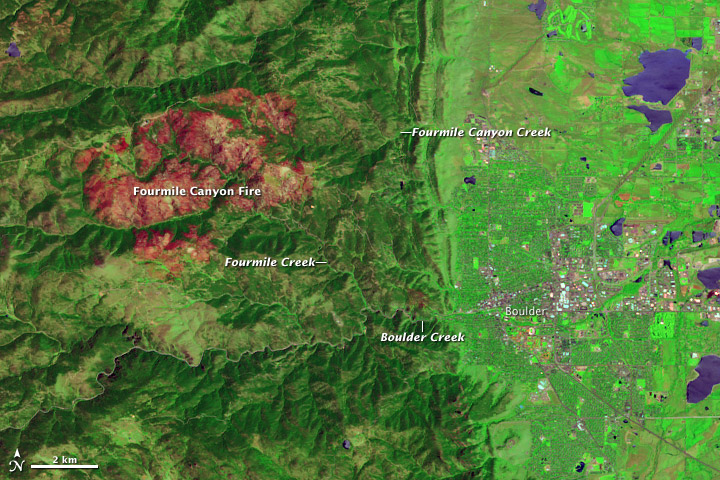Posts tagged Boulder
Boulder Burn Scar from Fourmile Canyon Fire and Story from NASA #boulderfire #boulder
Aug 2nd

In September 2010, the Fourmile Canyon Fire broke out in the foothills west of Boulder, Colorado, scorching more than 6,000 acres (2,500 hectares) and forcing residents to evacuate. Ten months later, residents had to evacuate again, this time to flee floods. Stripped of vegetation, the slopes along Fourmile Canyon soaked up little of the water dropped by a thunderstorm. Instead, the runoff surged into local stream channels.
On June 7, 2011, the Advanced Land Imager (ALI) on NASA’s Earth Observing-1 (EO-1) satellite observed the Fourmile Canyon burn scar. The top image is made from a combination of shortwave infrared and visible light. The bottom image is natural color.
The scar is more easily detected in the false-color image, where the burned area appears in shades of red and orange. Creek valleys, which generally escaped the flames in September 2010, form winding corridors of green through the scar. To the east and southeast, the city of Boulder lies on relatively flat land.
After the fire, the U.S. Geological Survey (USGS) warned residents to prepare for the possibility of flooding, even from small rainstorms. Late on July 13, 2011, such a storm occurred. As rain fell west of Boulder, Fourmile Creek rose rapidly. In fact, at one USGS gauge, the water discharge rate skyrocketed in a matter of minutes from 10 cubic feet per second to 350 cubic feet per second. The increased water flow translated into a 4-foot (1.2-meter) surge down the creek. Smaller surges followed later that night and over the next few days.
Fourmile Creek is a tributary of Boulder Creek, which flows eastward through the city. Water levels usually peak between mid-May and early July. But thanks to the melting of an unusually heavy snowpack, water levels on Boulder Creek were especially high when the July 13 thunderstorm struck. As residents in the Fourmile burn area were ordered to evacuate low-lying homes, emergency sirens also sounded in Boulder.
By late July 2011, water levels had receded along both the Fourmile and Boulder Creeks, although water levels in both remained above normal. Colorado’s monsoon season typically lasts from about mid-July to early September, so the possibility of more flooding remains.
Because of the angle of sunlight, these images may cause an optical illusion known as relief inversion.
References
Byars, M. (2011, July 13). Heavy rains hit Fourmile, prompt evacuations along Boulder Creek. Boulder Daily Camera. Accessed July 29, 2011.
Colorado Mountain Club. Protecting Yourself from Mountain Hazards. Accessed July 29, 2011.
Colorado Water Science Center. (2011, July 13). Video From Fourmile Creek at Orodell. USGS. Accessed July 29, 2011.
Colorado’s Surface Water Conditions. (2011, July 29). Boulder Creek at Boulder, Colorado. State of Colorado. Accessed July 29, 2011.
National Water and Climate Center. (2011, July 7). Weekly Report – Snowpack/Drought Monitor Update. U.S. Department of Agriculture. Accessed July 29, 2011.
National Water Information System. (2011, July 29). USGS 06727410 Fourmile Creek at Logan Mill Road near Crisman, Colorado. USGS. Accessed July 29, 2011.
National Water Information System. (2011, July 29). USGS 06727500 Fourmile Creek at Orodell, Colorado. USGS. Accessed July 29, 2011.
News staff. (2011, July 13). Thunderstorms pound area; flood sirens sound in Boulder. The Denver Post. Accessed July 29, 2011.
Ruddy, B.C., Stevens, M.R., Verdin, K.L., and Elliott, J.G. (2010). Probability and volume of potential postwildfire debris flows in the 2010 Fourmile burn area, Boulder County, Colorado: U.S. Geological Survey Open-File Report 2010–1244. Accessed July 29, 2011.
Snider, L. (2011, June 8). Boulder Creek swells as warm weather melts snowpack. Boulder Daily Camera. Accessed July 29, 2011.
NASA Earth Observatory image created by Jesse Allen and Robert Simmon, using EO-1 ALI data provided courtesy of the NASA EO-1 team and the United States Geological Survey. Caption by Michon Scott.
My landlord, the rabbit and the rattler By Ron Baird
Aug 1st
His shock of gray hair has usually been wet-combed across his head, kind of like Opie of Mayberry at 75 if he hadn’t gone bald. He favors flannel shirts, jeans and workboots and often has a pipe clamped in his teeth, puffing away without inhaling.
He talks about climbing Colorado’s mountains back in the late ‘40s and early ‘50s, when trips were made in old jalopies, the roads were narrow and winding and gear was primitive and heavy. He was at the University of Colorado then and he and a bunch of his climbing buddies scaled most of the 14ers in the state.
He graduated with a degree in some kind of engineering and has gone on to a full life of work and family here in Boulder. His wife is healthy, his kids are healthy and happy and have families of their own.
He’s building a steel-hulled boat in his back yard, has been for years, and fully expects to launch it into the ocean at some point in the future.
Jack is also a native of Boulder, grew up on a farm/ranch a ways north of town. He calls it a farm but I know that ground and there isn’t much that can be grown on it except cactus and wild grass and as it turns out subdivisions and mountain mansions. He was relating how lonely it was living out there as a kid.
I don’t know how we got around to it, but we were discussing rattlers, which were common back then. And he told me a story.
“One day when I was about 10, we heard the damnedest ruckus coming from the field behind the house and we went out to see what the hell was going on. When we got out there, there was a mother rabbit standing between a rattler and her babies, which were in a nest in the grass. I guess the rattler wanted to make a meal out of them babies and the mother was having none of it. When the snake started forward, she’d move towards it. The snake would coil and she would lunge, drawing a strike. At the last second, she would spin away and kick the snake in the head with both hind feet, knocking it away. The snake would gather itself and start forward and she’d do the same thing again. It was the damnedest thing I ever saw.
“Now, you have to understand that we weren’t very sentimental about such things back in those days. So we just watched. And besides, we’d never seen anything like that. Who could have imagined a momma rabbit would, or could, do something like that to protect her babies? But this went on for, I would guess, 20 minutes. Every time that snake started forward, she would kick it again. You could tell they were both getting pretty tired but the snake wasn’t giving up and neither was she. But the snake was bleeding from the eyes and mouth, and the bleeding was getting worse and worse. And it seemed to be disoriented and would lay there longer and longer before trying again. The rabbit would lay down, and its sides were fluttering she was breathing so hard. But when the snake got up so would the rabbit.
“Finally, the snake didn’t move anymore. I don’t think it was dead exactly, but it was dying. It’s head looked like somebody had hit it with a baseball bat. I wasn’t sure the mother rabbit was going to make it, either, but I’ll be damned if she didn’t finally she get up and hop to the nest where she had her babies.
“As I said, we weren’t too sentimental back then. We knew nature was hard. But I couldn’t stop thinking about how brave that momma rabbit was, so I went back to the barn and got a shovel and went out and cut that rattler’s head off, just to be safe. I think she earned that⎯not having to worry about that snake any more.”
Jack, even 65 years later, still shakes his head in admiration, as he finishes the story. “I’ve never stopped thinking about it.”
And now that I’ve heard the story, I can’t get the death duel of the momma rabbit and the rattler out of my head, either.
Survey shows Boulder voters support creation of a city-owned electric utility by a wide margin
Aug 1st
Other key findings include:
Seventy-one percent of those surveyed said the city would be better at offering renewable sources of energy and reducing carbon emissions than Xcel Energy.
A smaller, but majority, percentage (57 percent) thought the city could do a better job at finding innovative solutions to energy problems than Xcel Energy.
Xcel Energy, on the other hand, scored higher (67 percent) in providing reliable energy and (52 percent) in keeping monthly energy bills stable.
Reliability, service, control, energy sources and cost all received high marks as community priorities. Three of these were weighted against each other – low cost, increased renewable sources and having a say in utility decisions. Increasing renewable sources of energy were considered the prevailing priority among these by a majority of residents.
Sixty-five percent of those surveyed indicated they support the issuance of bonds to purchase Xcel’s system. Seventy-seven percent said they would either strongly support or somewhat support the extension/expansion of either the Climate Action Plan or Utility Occupation Tax to cover interim legal and engineering expenses necessary to determine final acquisition and start-up costs.
Ninety-one percent of those surveyed said they would support an increase of between 5 percent to “as much as it takes” in their monthly electric bills to reduce carbon emissions and/or increase renewable sources of energy.
Voters were even more likely to support the creation of a city-owned electric utility if there was a possibility of spending limits, a re-evaluation of final costs before a decision is made about whether to issue bonds and rates within 10 percent of those offered by Xcel Energy. Education about the existence of the 29 other locally-owned utilities in Colorado also made a positive difference.
“The decision our community makes regarding our energy future will be a historic one. These results show that the City of Boulder has listened carefully to our community as we have set our objectives and studied our energy supply options,” City Manager Jane S. Brautigam said. “While we are on the track that many voters support, we also know that taking a measured and prudent approach to this analysis is crucial. We pledge to continue working responsibly and objectively to understand the potential impacts and benefits to all segments of our community.”
The survey, conducted by National Research Center Inc. in Boulder, reached 1,265 registered voters and resulted in 400 completed responses. The response rate of 32 percent was one of the biggest the survey firm has seen in recent years. The results have a margin of error of +/-4.5 percent. The survey occurred between July 6 and July 18.
Tomorrow night’s council meeting will begin at 5 p.m. tomorrow, Tuesday, Aug. 2, in Council Chambers, 1777 Broadway. Elected officials are expected to hear a brief presentation about the survey findings and ask questions before discussing and then voting on ballot language related to how Boulder gets it energy in the future. There will be an opportunity for public input. The decisions council makes at this meeting are expected to form the basis for a third – and final – reading of ballot language on Tuesday, Aug. 16. The election is Tuesday, Nov. 1.
The complete survey report is available at http://www.boulderenergyfuture.com.





















